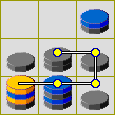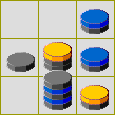Page 6 of 18
Pilare
No applet
 | Pilare is a board game designed by Basque game author Jorge Gómez Arrausi. It won a proxime accessit award in the games creation contest of Tona, 2005. Arrausi is arguably the best human Lines of Action (LOA) player of the world. He lives in Basuri near Bilbao. Pilare is a 'stacking game', which resembles mancala games since pieces are sown in a mancala-like manner. On the other hand, it has a certain affinity with other elimination games that employ stacks or columns, like Focus and Explocus. And as in these games, one must embark on a journey littered with unsettling tactics before the contours of strategy emerge. In Pilare its all about the creation and defense of large columns that can smear their content over a large area, diminishing the opponent beyond recovery. Easier said than done of course. |
Rules
The game is played on a 6x6 or 8x8 board. There are two players, Red and Black. Each player has ten (fourteen) men in his color. There are an additional 36 (64) neutral black men in the game. The diagram shows the 6x6 board with the pieces in the initial position.
Object
The object of Pilare is to leave the opponent without legal moves.
Mechanics
Starting from the Red player, each player picks up any whole stack of men with his color on top (a single man is considered to be a stack too).
After picking up the stack, the player places its bottom man on a square that is horizontally or vertically adjacent to the source square. If the square is not empty then the new man is placed on top of the square's stack. Then the player takes the next man from the bottom of the stack and places it on a square that is horizontally or vertically adjacent to the previous square. The player continues distributing the stack, until all its checkers are placed on the board. After placing each checker the player can change direction but it is forbidden to make a 180 degrees turn.
Here's a 'before and after' example that should be self explanatory:
 |  |
External links
Pilare © Jorge Gómez Arrausi
